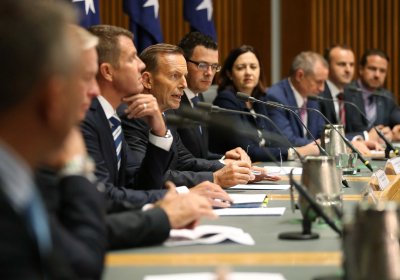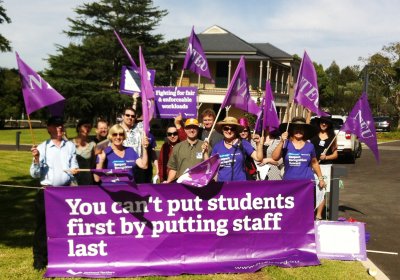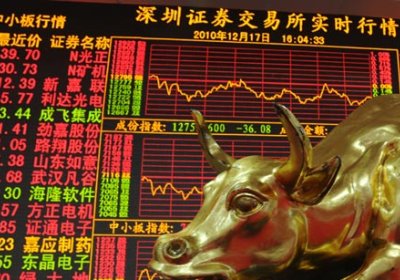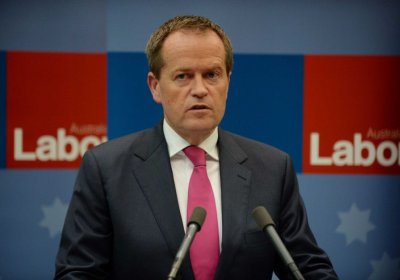Despite the overwhelming evidence, the federal government does not believe that climate change is real. The Climate Council recommended a reduction of 45% to 65% of Australia’s 2005 carbon emission levels as the minimum that would be required to prevent runaway climate change.
John Rainford
Why was John Dyson Heydon QC liberal prime minister Tony Abbott’s “captain's pick” to run the royal commission into the trade unions?
It could be from the shared solidarity that you’d expect of Rhodes scholars. Or perhaps it was just innocent association from the time former Prime Minister John Howard appointed Dyson Heydon to the High Court in 2003, a position he retired from under the compulsory age rule of 70 in 2013.
The financial scandal in the Health Services Union (HSU) involving its national president Michael Williamson and former national secretary Craig Thompson ended in the courts when both of them were convicted for fraud and theft offences.
It became the trigger for Prime Minister Tony Abbott to announce on February 10 last year that he was setting up a Royal Commission into Trade Union Governance and Corruption headed by former High Court judge Dyson Heydon.
It is now more difficult for unemployed people to find a job than it has been for 20 years. Official youth unemployment is 12% and the official national jobless rate has risen to a 13-year high of 6.3%.
The last time employment prospects were so depressed was in the 1990s when the national unemployment rate was 8%. In South Australia, the official unemployment rate is now 7.9%, with employment growth a negligible 0.3%.
For a long time, superannuation was available only to permanent public sector workers and managerial employees in the private sector. So-called “blue collar” workers were not so privileged. In the mid-1980s, only about a quarter of these workers had access to superannuation, more often than not following union-led campaigns in targeted industries.
When Tony Abbott’s government asked the Productivity Commission to review Australia’s “workplace relations framework” it was for the sole purpose of providing it with cover for more attacks on workers’ pay and conditions.
One of its terms of reference was to examine the ability that employers had to “flexibly” manage and engage with their employees.
Flexibility is a word that once commonly conveyed a positive sense of resourcefulness and adaptability. But the notion of flexibility that the Productivity Commission refers to is one shaped by employers.
In 1870, six months before a retreating French army was defeated by Prussian troops at Sedan, the Deutsche Bank was established in Berlin.
Although Britain was still the pre-eminent world economic power, the US and Germany were starting to take the giant strides that would soon enough see them leave the former “workshop of the world” in their wake.
When Gough Whitlam’s Labor government abolished university fees in January 1974, student enrolments had already been increasing at double the population growth for two decades.
In 1985, three years before Bob Hawke’s Labor government abolished free tertiary education and brought in the Higher Education Contribution Scheme (HECS), it had decided to develop the full-fee international marketing of education as an export industry.
The neoliberal agenda for the Council of Australian Governments (COAG) meeting in Sydney on July 23 was set by NSW Premier Mike Baird, who proposed increasing the GST from its present 10% to 15%.
Baird wants the extra funds to be primarily used to fund health services, which account for almost 30% of state budgets, including spending on hospitals of about 20%. What he neglected to say was that under his mate Tony Abbott’s federal government, spending has been drastically reduced on health along with education. The total reduction across both areas is about $80 billion.
Casuals now make up about half of the academic workforce in Australia’s universities. For most of them it is precarious work at its worst.
Those lucky enough to get two 13-week sessional contracts a year are unemployed academics for the other half of the year, forced to then compete with a growing precariat for temporary employment elsewhere while still at the call of their part-time employer. And the 13 weeks are not necessarily standard 35-hour weeks, they can be for as little as one hour a week.
Australia managed its way through the Global Financial Crisis (GFC) in better shape than most countries, mostly due to two factors.
The first was $83 billion in Australian government stimulus spending, the third largest in the world as a percentage of GDP, behind the US and South Korea.
The second was resilient demand for iron ore and coal exports to China which came from an initial US$4 trillion in Chinese stimulus spending organised through the country’s banks.
From his late teens, Bill Shorten would tell anyone who listened that his ambition was to be Labor prime minister, following in the footsteps of his heroes Bob Hawke and Paul Keating. But first of all he had to find a faction because, in the Labor Party, it is the factions who have the power to select MPs, premiers and prime ministers.
- Previous page
- Page 3
- Next page











